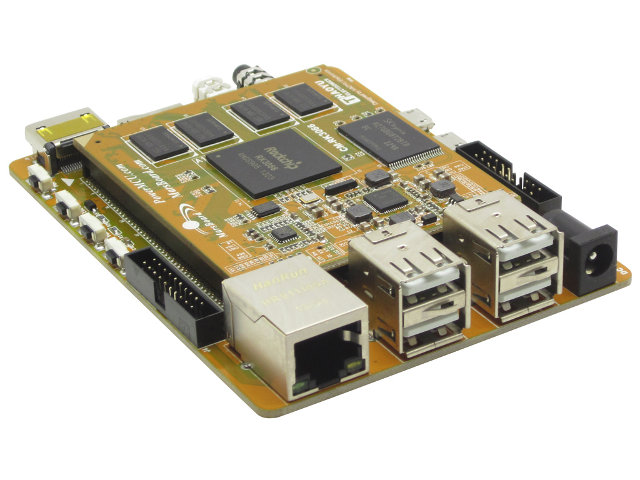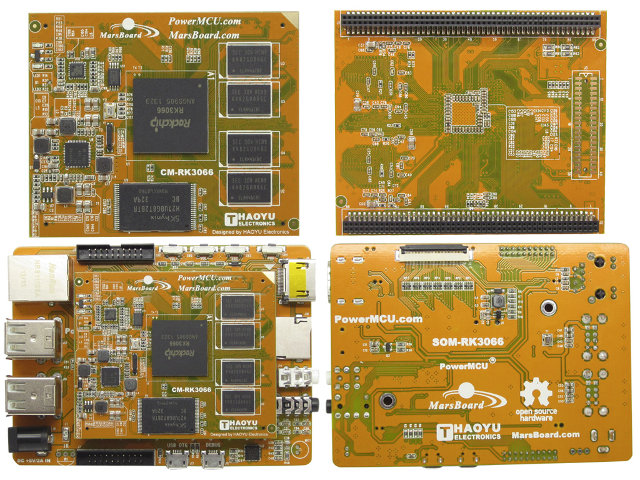Until now if you wanted a low cost Rockchip development board you’d have to go with Radxa Rock (Quad core RK3188) or WaxBerry Pi2 (Dual core RK3066). Thanks to Haoyu Electronics , the company who made MarsBoard A10, there’s now another option with MarsBoard RK3066 powered by Rockchip RK3066 dual core Cortex A9 SoC with 1 to 2 GB RAM, 4 to 8 GB Flash and lots of ports and expansion connectors.

MarsBoard RK3066 is composed of a baseboard (SOM-RK3066) and a computer on module (CM-RK3066) with the following specifications:
- CM-RK3066 Computer-on-Module:
- SoC – Rockchip RK3066 dual core ARM Cortex A9 @ 1.6Ghz + Mali-400MP4 GPU
- System Memory – 1GB DDR3 SDRAM up to 2GB
- Storage – 4GB Nand Flash & eMMC FLASH
- Power Management Unit – TPS659102
- Misc – TX indicator LED use for debug, Power Indicator LED
- 10/100M Ethernet PHY – LAN8720A
- SOM-RK3066 Baseboard:
- Storage – micro SD card socket up to 128 GB
- Video Output – HDMI A Type socket, LCD interface
- Audio – Headphone and speaker output, microphone (not soldered), Audio Codec IC ALC5631Q
- Connectivity – RJ45 10/100M Ethernet
- USB – 4 x USB 2.0 Host port, Micro USB DEBUG port (vai CP2102), Micro USB OTG port
- Misc – IR Receiver (not soldered), CR1220 battery holder for RTC, VOL + (Recover Key), VOL -, ESC, and Power Keys
- Expansion Port – 2x 20 pin headers (including Camera CIF signals),
- Power Supply – 5V/2A

A 7″ TFT LCD display with capacitive touch panel (Model HY07CTP-A) with 800×480 resolution, is also available for purchase and supported by the firmware. The company provides firmware for Linux (PicUntu) and Android 4.2.2, and if you go over the download page, you’ll find links to hardware schematics (PDF only), software tools for Windows and Linux, and firmware files to boot from flash or micro SD card. There’s also a link to their FTP server, where you’ll find Android 4.1.1 and 4.2.2 SDK, Orcad schematics, PCB layout and gerber files for the baseboard, datasheets for the main components, and some more documentation. As usual, there does not seem to be any license attached to the hardware files. The company has also setup a wiki and a forum for the board, albeit there’s not much to see there for now.
MarsBoard RK3066 and the touchscreen display can be purchased for respectively $60 and $35 including shipping via Haoyu Electronics e-Store (hotmcu). You can visit MarsBoard.com for more information.

Jean-Luc started CNX Software in 2010 as a part-time endeavor, before quitting his job as a software engineering manager, and starting to write daily news, and reviews full time later in 2011.
Support CNX Software! Donate via cryptocurrencies, become a Patron on Patreon, or purchase goods on Amazon or Aliexpress





They just copy the wiki from radxa, sigh. Even so lazy to remove the word from us.
Looked around but couldn’t find it: do we know how many touch points the screen supports?
@newmiracle
Found it in the documentation. 10 touch points. For the price, thats a deal (if it works fully…)
They should have it more prominently on the product page, imo.
I purchased their A10 and A20 board. They don’t have good OS support, just copy paste from Cubie
@Tan Alie
This is bullshit. MarsBoard A10/A20 not used PMIC, hardware and CubieBoard completely different hardware. So OS firmware can not be compatible,copy and paste can not be used. In fact,We use the official firmware compiled and buillded for MarsBoard A10/A20. Because there is no PMIC, we feel not perfect, so we designed a new MarsBoard A10/A20.
This is bullshit. MarsBoard A10/A20 not used PMIC, hardware and CubieBoard completely different hardware. So OS firmware can not be compatible,copy and paste can not be used. In fact,We use the official firmware compiled and buillded for MarsBoard A10/A20. Because there is no PMIC, we feel not perfect, so we designed a new MarsBoard A10/A20.
@Tom Cubie
@Thomas Tang
As you both seem to be fighting in the same area…
How about someone finally move into doing server/cluster style systems (for us poor souls needing to use Avoton systems for network proxies/routers) to finally go full blown ARM infra?
A-la Gumstix Stagecoach and Avoton 4+ Ethernet boards?
And please, skip including any of that WiFi EMI on your boards, the external USB sticks beat those integrated ones hands down.
@anon
This, a thousand times this. Especially the bit about the barely-functional wifi…
There’s a review (in Polish) of the Marsboard RK3066 + LCD display – http://www.jarzebski.pl/blog/2014/03/19/marsboard-rk3066-czesc-1-unboxing-i-android.html#prettyphoto